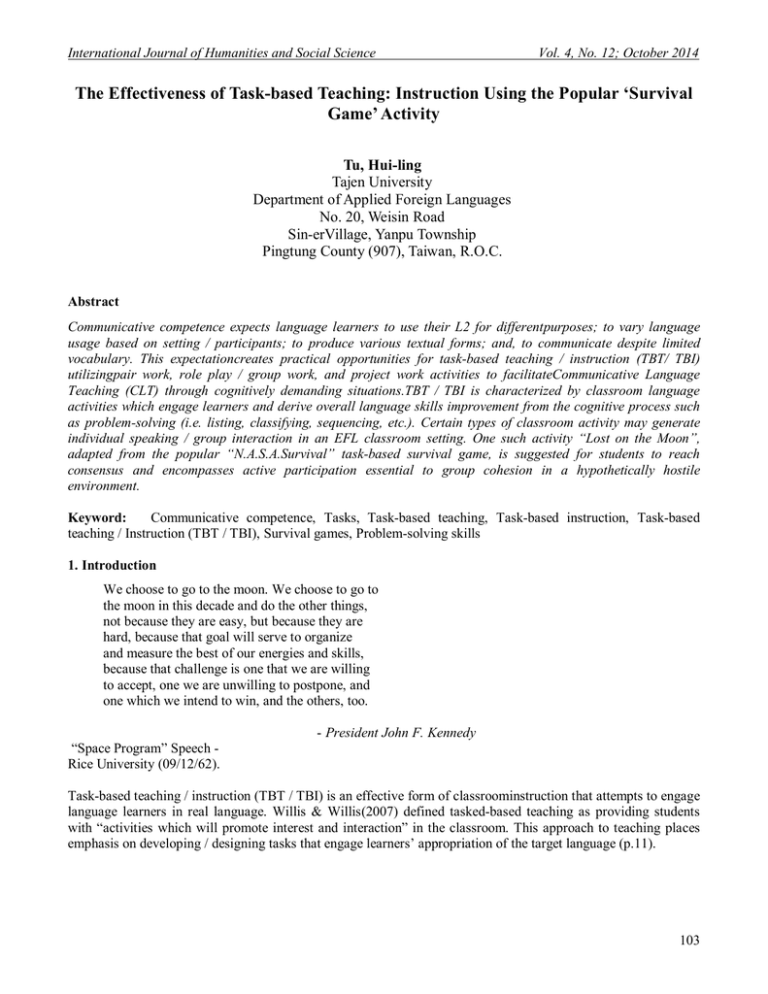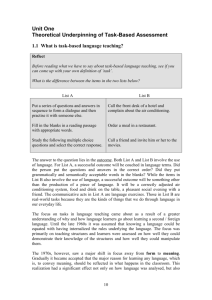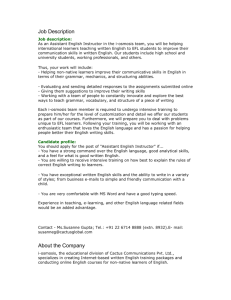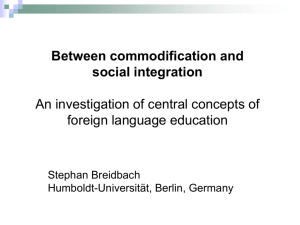Document 10466094
advertisement

International Journal of Humanities and Social Science Vol. 4, No. 12; October 2014 The Effectiveness of Task-based Teaching: Instruction Using the Popular ‘Survival Game’ Activity Tu, Hui-ling Tajen University Department of Applied Foreign Languages No. 20, Weisin Road Sin-erVillage, Yanpu Township Pingtung County (907), Taiwan, R.O.C. Abstract Communicative competence expects language learners to use their L2 for differentpurposes; to vary language usage based on setting / participants; to produce various textual forms; and, to communicate despite limited vocabulary. This expectationcreates practical opportunities for task-based teaching / instruction (TBT/ TBI) utilizingpair work, role play / group work, and project work activities to facilitateCommunicative Language Teaching (CLT) through cognitively demanding situations.TBT / TBI is characterized by classroom language activities which engage learners and derive overall language skills improvement from the cognitive process such as problem-solving (i.e. listing, classifying, sequencing, etc.). Certain types of classroom activity may generate individual speaking / group interaction in an EFL classroom setting. One such activity “Lost on the Moon”, adapted from the popular “N.A.S.A.Survival” task-based survival game, is suggested for students to reach consensus and encompasses active participation essential to group cohesion in a hypothetically hostile environment. Keyword: Communicative competence, Tasks, Task-based teaching, Task-based instruction, Task-based teaching / Instruction (TBT / TBI), Survival games, Problem-solving skills 1. Introduction We choose to go to the moon. We choose to go to the moon in this decade and do the other things, not because they are easy, but because they are hard, because that goal will serve to organize and measure the best of our energies and skills, because that challenge is one that we are willing to accept, one we are unwilling to postpone, and one which we intend to win, and the others, too. - President John F. Kennedy “Space Program” Speech Rice University (09/12/62). Task-based teaching / instruction (TBT / TBI) is an effective form of classroominstruction that attempts to engage language learners in real language. Willis & Willis(2007) defined tasked-based teaching as providing students with “activities which will promote interest and interaction” in the classroom. This approach to teaching places emphasis on developing / designing tasks that engage learners’ appropriation of the target language (p.11). 103 © Center for Promoting Ideas, USA www.ijhssnet.com Richards (2006) says that the majority of language teachers today employ a “communicative language teaching” (CLT) approach in their classroom as a matter of Choice (pg.2). This teaching method sets as its primary goal communicative competencewhich considers that learners to know the following: how to use the target language fordifferent purposes and functions; how to vary language usage based on setting and participants; how to produce and understand various forms of test (e.g. narratives, reports, interviews,conversations, etc.); and, finally, how to maintain communications despitelimited vocabulary or insufficient language knowledge (e.g. learning strategies). To this end, TBT / TBI utilizes pair work activities, role plays, simulations, group work activitiesand project work to facilitate CLT by producing cognitively demanding situations thatdirectly teach learners in tasks that enhance this process to take place. Language learning tasks may be characterized as activities that are used in the classroom to engage learners to produce real language. A broad form of tasks may bederived from the cognitive process of problem-solving. Students can be asked to performspecific tasks, such as listing, ordering, classifying, and sorting. This process may be further facilitated through the use of visual / graphic clues or prompts that relate to newvocabulary to real items or actions (i.e. the items listed in the proposed “survival game’).Willis and Willis (2007) consider that problem-solving activities (e,g. listing and ranking the effects of the problem in order of severity) not produce group discussion, but They also stimulate a wide range of writing activities such as note-taking, drafting and finalizing proposals for solutions (pp. 93-94). Thornbury (2005) considers that communicative tasks are fundamental. This view holds speaking to be a cognitive skill, whereby language knowledge becomesincreasingly automated through successive practice and then repetition (pg.79). SimilarTo the previously cited Willis & Willis (2007), Thornbury also chooses to characterizewholly communicative activities in a number of specific ways: the motivation of the activity is to achieve some outcome, usinglanguage; the activity takes place in real time; achieving the outcome requires the participants to interact; i.e. tolisten as well as to speak: because the spontaneous and jointly constructed nature of the interaction, the outcome is not 100% predictable; and, thereare no restrictions on the language to be used (pg.79). Willis and Willis (2007) proposes a “mind-map” that specifies seven broad parameters that are useful for adapting / refiningtasks to meet instructional needs in TBT / TBI classrooms. These parameters include, but not limited to: Any possible outcome: Open or closed; A starting points for task; The need for pre-task preparation; Control of agenda and task structure; Recognizable interaction patterns and participant roles; Pressure on language production among participants; and, Post-task activities (pg.157) 2. General Activity Discussion The activity proposed in this paper is centered on adult learners in as EFL / ESLclassroom. Before engaging in discussion of the proposed activity, it is important to askthe same question first posed by McKay & Tom (1999), when they asked, “What do adultlearners bring to class?”and, then they self-answered it by providing: 1. Language - L1 knowledge; social constraints not to feel embarrassed (loss of face). 2. Background Knowledge of the real world. 3. ExpectationsDiffering attitudes / experiences. 4. Learning styles Different and preferential. 5. Confidence Most important aspect - supportive. 6. Motivation - Variable (Based on interests). 7.Circumstance -Age, health, flexibility that requires the teacher to become informed.(pp.2-5) 104 International Journal of Humanities and Social Science Vol. 4, No. 12; October 2014 This form of activity was chosen partially on the basis that “older learners”,especially students in language classrooms, are more likely to receive only limitedexposure to the second language throughout their study. This means that activities shouldbe interesting and engaging, without being too demanding because of that limitedexposure. This is a difficult and realistic set of circumstances for any ESL teacher toaccept, since we all hope that English would be the center of learning for our students. However, it is entirely possible to formulate and activity that will challenge mostlanguage learners if certain assumptions about language learning (i.e., those that underliesecond language acquisition (SLA) success) can be made. Mckay & Tom (1999) provide a list of given considerations for developing any activity: 1.) Learning a language is an integrated process (does nothappen singularly, occur in a vacuum. 2.) Mistakes are a normal and necessary part of the language-learning process – Corrections should be made thrucollective restatement. 3.) The classroom atmosphere directly affects learning – itshould be friendly and supportive. 4.) The learner is an active partner in the overall learning process. (pg.15) These assumptions are validated in Ur (1981) which discussed how the teaching of English as a foreign language (EFL) requires fluency practice in order to take place. Inher 1981 book “Discussions that Work”, Penny Ur said that language should be used“creatively, purposefully, individually, and in discussion as a group”. This author adds, effective discussion promotes learning through the use of interesting topics, group-work,role-play exercises, task focus, and the organization of processes (pg.1). 3. The Survival Game: “Lost on the Moon” The subject of this paper is about how a specific classroom activity can generateindividual speaking and group interaction in an EFL classroom setting. At the same time,such an activity accommodates a variety of “learning styles (Reid, 1995) sincelearners are known to possess different cognitive learning processes whenever they acquire language. A game activity is proposed that will provide enhanced input for languagelearning in a classroom setting. The role-playing game is called “Lost on the Moon“. It isadapted / modified from the popular “N.A.S.A Survival” game, which according to Ur(1999) “is easily the most well-known” survival game in use (p.70). This discussionactivity asks students to work individually, then in pairs, and then finally as a group to perform a common task. Participants are asked to reach a consensus related the listing of communally agreed upon priorities that are seen as essential to survival in an imaginaryenvironment. The environment is the lunar surface and is both hypothetical and hostileto the learner, thus presenting critical thinking problems for learners to solve through thetargeted use of real language. The“N.A.S.A Survival” game was originally designed for the U.S. National Airand Space Administration (NASA) as team-building exercise to promote group-decision making in any native language. According to Pfeiffer & Jones (quoted in Ur(1981) – no reference), this game is widely used to teach reasoning as it relates to thedecisionmaking process; however, it may also be effective as an ESL / EFL activityintended for adult learners. It may be further modified for younger students wishing toparticipate by introducing more less-remote locations and more rudimentary survivalneeds to facilitate discussion. The game itself actually originates from an earlier version of a survival game usedfor the training of clandestine operatives of the U.S. Office of Strategic Services (OSS)during WWII. This organization is best-known as the predecessor of the modern dayCentral Intelligence Agency (CIA). Quick decision-making skills in foreign languagemight result in the difference between life and death for an agent operating in enemyterritory. The game has continued to be modified for use at the United States MilitaryAcademy (USMA), for the Boy Scouts of America (BSA), and then as part of ESL / EFL curriculum in many communicative settings. For purposes of this paper, the game “Lost on the Moon” was adapted / modifiedfor use in the EFL / ESL taskedbased classroom (Rogers, 1978; Ur, 1981; Klippel, 1984).Meaningful communication among participants ultimate goal is the achievementof fluency, is the fundamental purpose of this language-learning activity. The objective of the activity is to integrate / facilitate the teaching of oral communications skills withactual speaking by promoting individual participation, critical thinking, vocabulary use,and then group activity to solve a commonly-held problem. 105 © Center for Promoting Ideas, USA www.ijhssnet.com 4. Activity Design “Lost on the Moon” - Survival Game-Group Discussion Activity [Adapted/modified from Ur, P. (1981), pp.7073)].This game is to be modeled at a student level of “Intermediate / Upper-intermediate – (CEF-B2~B1) for Adult ESL / EFL Learners. The game is to be structuredin the following manner: 1.) Preliminary Session - (5~7 min. Teacher explanation) a.) b.) Join “team” pair-work dyads among participants: “Work with a partner to …” Provide the following handouts to participating teams: (1.) “Mission Control…” role-play explanation sheet. (2.) “My List” – inventory of survival items. (3.) “Team List” – graphic inventory of survival items. c.) Provide the narrative structure of the game by reading the “Mission Control…” role-play instructions before beginning the game. d.)Make sure that all of the vocabulary items are understood byparticipants by pointing out the graphic examples found on the “Team List”. e.) Answer any questions the participants may have before beginning. 2.) Group Discussion – (10~20 min. Activity) a.) Step1:Begin the “game” by asking each participant to individuallycomplete the“My List” handout without assistance from their teammate. There is to be no group discussion at this time. Participantsmay refer to the “Team List” handout to qualify vocabulary using visual clues provided, but they should perform this task independent of their team partner. “Important” - Maintain thisaspectof the game to insure that the primary objective of subsequent discussion / agreement is accomplished. b.) Once participants have defined their individual priorities on “MyList” then they should then compare their list to their partner’s listand discuss it only with their partner, not with other groups. c.) Step2: Participants should use both lists to decide what differencesexist and then resolve those differences so that all of the priorityitem listed on “Our List” will be the collective choice of bothteam members. d.) Step3: Each “Team” will be asked to report their “Top 5” choicesby posting them on the white board in front of the class usingmagnets provided for this purpose. e.) The class will then be asked to review the “Top Five” itemsprovided by each team, to find out whether or not each prioritizeditem is the same on their list, or if they are not the same sequentialorder;and if so, why not?. f.) Class discussion should be open to discuss any choices that are inthe minority and those teams should report why they picked those“survival” items vs. the majority items picked by the other teams. 3.)Feedback–( 5~10 min. – Conclusion- End of Task cycle) a.)Provide the background of the game and then the final “definitive”(NASA) solution. b.) Vote for a final list consensus, if required. c.)This final “report” stage allows participants to appropriatelyrecycle, refine and extend the language they have learned whileplaying the game. 5. Justification for the Activity This activity was chosen to allow participants to speak using real language inconjunction with their use of critical reasoning skills during the performance of a task.This task consists of “prioritizing” a list of needed equipment for the imagined survival of the team or group in a hypothetical, hostile setting. Students are expected to discuss,choose, argue, agree upon, and then explain a set of priorities that may be familiar orunfamiliar to them. It will require the use of vocabulary acquisition and also the ability toperform the task to possible completion. 106 International Journal of Humanities and Social Science Vol. 4, No. 12; October 2014 Throughout the activity, the task-based classroom teacher must assume a varietyof roles as an instructor. These roles focus attention on leading and organizing discussion,classroom management, adviser, motivator, facilitator, and the traditional role of language teacher. The teacher is responsible for controlling the learning environment and must be aware of time and interest constraints while doing so. Lee and Van Patten (1995)considers that as the teacher’s roles begin to shift, so do the roles of the students’.Interestingly, the primary role in the TBT / TBI classroom is either as “resource person”who responds to specific needs or as an “architect” who processes information for use by the students (pp.67-68). 6. Evaluation in the Activity Setting: Benefits and Criticism Generally speaking evaluation techniques related to TBI can take place in a number of ways. Since this game activity is designed to promote speaking and reasoning,these are the two elements I shall focus upon. In group and pair work discussion, likewhat takes place within the game, evaluating the information available to the group isonly the first element of critical thinking. Galanes and Adams (2007) consider it equallyimportant to evaluate how both information sources and group members’ reasons from the information provided or obtained (pg.306). They suggest that valid reasoning shouldconnect plausible information with conclusions in an appropriate and defensible way. This means that the fallacies of overgeneralization, ad hominem arguments, suggestion ofunreasonable causal relationships, positioning of false dilemmas, and faulty analogiesshould all be refrained from during performance of the task. Based on the classroom experience while using this activity, I would suggestflexibility while teaching a taskbased curriculum. Students must be allowed to find theirown way towards solving the “issues”, “problems” or assuming the “roles” they havebeen given, so teachers must adopt a subordinate role. Sometimes these tasks, albeit“real-world”, may be wholly foreign to the students’ experience and require genuineeffort to reason or comprehend. Above all, students are best served if teachersconcentrate on the writing of clear, easy-to-follow instructions that are at the heart of anyeffective lesson plan based on the TBT/TBI method. The perceived benefits of using an inventory prioritization activity, such as “Loston the Moon”, are that “survival games” are less abstract in their execution than manyother classroom activities. Although reasoning is an integral part of many activities, thiskind of a game requires less “intellectual” effort and more creativity on the part of students to determine solutions to problems during performance of the task. “Survival”games are based on dramatic, urgent situations that require input from those directlyinvolved. Discussion does not have to be overly demanding, yet it can remain complex,entertaining and absorbing to the participants. This philosophy of outside engagement isthe game as what is used to draw viewers or readers to “survival” situations in books, on TV or film. The limitations of this activity are that it requires specific, integral vocabularyknowledge that must be provided for meaningful activity interchange to take place.Participants are also required to use their imaginative capacities to consider specific“hostile” environments that would necessitate survival skills and equipment use. Consideration should be made that the need for group / team unanimity may causea long, drawn-out discussion that would effectively prevent full individual participation.This requires for the teacher to act as a “moderator” in the discussion if such an outcometakes place. Generally speaking, if group discussions that have taken place have beenlong and thorough, then summing up should remain brief. If, on the other hand, groupdiscussions have been short and superficial in nature, then the group should proceed witha general form of debate until consensus is reached or an impasse is drawn. This activity is easily replicated in a host of other environmental settings where“group survival” might be an issue. A list of suggested “environmental” settings isprovided with a companion list of items necessary for survival in such hostileenvironments. As previously mentioned, the popularity of such a game should not beunderestimated in light of such popular network and syndicated television programs suchas “Survivor” or “Lost”, or Hollywood blockbuster films such as “Castaway(1986)”, “Gravity (2013)”, or “Interstellar(2014)”. 107 © Center for Promoting Ideas, USA www.ijhssnet.com Criticism of the task-based teaching / instruction (TBE / TBI) method is discussed in Richards (2006): Many issues arise in implementing a task-based approach. To begin with,there is little evidence that it works any more effectively than the P-P-P approach it seeks to replace. Criteria for selecting and sequencing tasks arealso problematic, as is the problem of language accuracy. Task work maywell serve to develop fluency at the expense of accuracy, as with some of the other activities suggested within the CLT framework. Content issuesare also of secondary importance in TBI, making it of little relevance tothose concerned with CBI or mainstreaming. The fact that TBI addressesclassroom processes rather than learning outcomes is also an issue. Incourses that have specific instructional outcomes to attain (e.g. examination targets) and where specific language needs have to be addressed rather than the general communication skills targeted in theirtask work, TBI may even seem too vague a methodology to be widelyadopted (pg.35). Despite the relevant criticism and problems teachers face when using TBT, anyfocus should be placed on how the proven methodology works within the inherently larger CLT framework. This focus is on input to the learning processand how instruction can better serve the learners’ collective and individualinterests towards achieving autonomy. 7. Conclusion The implications for a communicative language teaching pedagogy are evidentsince it affords learners a better opportunity to acquire real communication skills.Richards (2006) summarized the principles behind using this approach as follows: Make real communication the focus of language learning. Provide opportunities for learners to experiment and try out what they know. Be tolerant of learners’ errors as they indicate that the learner is building his or her communicative competence. Provide opportunities for learners to develop both accuracy and fluency. Link the different skills such as speaking, reading, and listening together, sincethey usually occur so in the real world. Let students induce and discover grammar rules (pg.13). The proposed activity “Lost on the Moon: Survival Game” was suggested in such a way as to engage learners’ in a language-centered, task-based activity. There is no sense of accuracy, outside the larger consideration of agreement or disagreement of the prioritiesset forth in the exercise. This aspect of game-play should serve as the catalyst fordiscussion, whereby all of the participants of the game will voice affirmation or objectionto what is bought forth. Language usage, communication achievement, communicationstrategy, and linking the learners’ language to the context of the game are all meant tofacilitate the acquisition of language fluency. The ranking task of placing all of the items on both lists in order of importanceasks students to compare values, share opinions and question beliefs. By completing thistask, participating students will have the opportunity to acquire unfamiliar real-languagevocabulary, stimulate discussion in a communal setting, and gain a sense of sharedaccomplishment. The individual (“My List”), pair work (“Team List”), and group work(“Mission Debriefing”) facets of the game should help students to develop different levelsof motivation and a personal sense of accomplishment when the task is completed. The real focus of introducing this exercise is to promote learner autonomy bygiving students a greater choice over their own learning experience. Thornbury (2005) regard the purpose of this focusin the following way, “Speaking activities involving a drama element, in which leaners take an imaginative leap out of the confines of the classroom, provide a useful springboard for rea-language use” (pg.96) Ultimately, the aim of this activity, supported in Jones (1982), is not to producethe “correct words, grammar, and pronunciation, but to communicate effectivelyaccording to roles, functions, and duties.” ((p.38) Therefore, it is best to take a relaxedattitude and “do too little rather than do too much” (p.39) to help students learn fromsuch a task. Finally, Shie (1991) provides an apt bit of advice those teachers who chooseto use game activities (tasks) in their class room, “EFL games can promote learners’motivation not only through their changeable forms of activity and kaleidoscopic natureof engagement, but also through their positive effect on foreign language anxiety(pp.113-114). 108 International Journal of Humanities and Social Science Vol. 4, No. 12; October 2014 References Galanes, G.J. (2007). Effective group discussion: Theory and practice,(12th ed.). Boston,MA: McGraw-Hill Educational Publishing. Jones, K. (1982). Simulations in language teaching. Cambridge:CUP. Klippel, F.(1984).Keep talking: Communicative fluency activities for languages teaching.Cambridge:CUP. Lee, J.F & Van Patten, B.(1995).Making communicative language teaching happen (2ndEd.). Singapore: McGraw Hill International. Mckay, H. & Tom, A.(1999). Teaching of adult second language learners.Cambridge:CUP. Reid, J. (ed) (1995). Learning styles in the ESL / EFL classroom. New York: Heinle&Heinle. Richards, J.C.(2006). Communicative language teaching today. Cambridge: CUP. Rogers, J. (1978). Group activities for language learning. SEAMEO Regional LanguageCentre occasional Papers, No. 4 Singapore: SEAMEO Regional Language Centre(MS). Shie, J. S. (1991). Aspects of ESLgames.Taipei, Taiwan: Crane Publishing Company,Ltd. Thornbury, S. (2005).How to teach speaking. Harlow, Essex (UK): Longman-Person. Willis, D. & Willis, J. (2007).Doing task-based teaching. Oxford: OUP. Ur, P. (1981). Discussions that work: Task-centred fluency practice. Cambridge: CUP. 109





